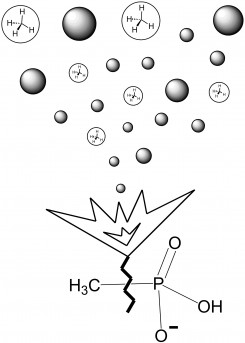Methane: we’ve all heard of it, we’ve all inhaled it at some point or another, but do we know where it comes from? Researchers from the University of Illinois have recent come to a fairly conclusive answer.
Scientists have known for many years that anaerobic (oxygen-free) bacteria produce methane. It has always been a puzzle that aerobic (oxygen-containing) areas of the ocean harbor vast amounts of the natural gas — up to four per cent of the global methane budget. Clearly, this methane isn’t coming from anaerobic bacteria but rather from aerobic bacteria. No known biosynthetic pathways in aerobic bacteria even came close to explaining how such a simple molecule (four hydrogen atoms attached to carbon) as methane could be given off as a metabolic by-product.
The first clue to solving the puzzle came from the labs of professors William Metcalf and Wilfred van der Donk, who were interested in finding new antibiotics. They were trying to discover bacteria that could make organophosphonates, an intriguing class of chemicals that contain a carbon-phosphorus bond. This bond, when present in antibiotics, helps the drugs stay resistant to enzymatic breakdown and are thus able to neutralize the defenses of the bacteria.
The researchers found a microbe, N. maritimus, which seemed to contain the enzymatic machinery capable of synthesizing these sought-after phosphorus compounds. Of particular importance, they detected a very special molecule, methylphosphonate (see graphic), which had previously been known to undergo enzymatic degradation to methane. So it seemed as though the paradox was solved: methylphosphonate can turn into methane with the action of certain enzymes. There was a catch though: nobody had ever detected methylphosphonate in aerobic bacteria.
The researchers were able to prove, with a series of experiments, that another molecule called HEP can be converted to methylphosphonate by their special breed of bacteria N. maritimus. It turned out that N. maritimus had just the right set of enzymes to do the job of making methane from phosphorus-containing molecules. The type of chemistry that the researchers discovered, involving the direct cleavage of carbon-phosphorus bonds, is very exotic and unusual. The strangeness of these reactions bears testament to the versatile life-forms evolution can produce. When faced with harsh environments, bacteria can evolve to metabolize almost anything to obtain the nutrients they need to survive.
The effort required to analyze the biochemical pathways leading to methane production in N. Maritimus was enormous. The researchers were required to clone the enzyme responsible for the synthesis of methylphosphonate in the cell cultures of bacteria. Difficulties arose due to the very small genome size of the bacteria (one-tenth the size of an average lab rat microbe), which limited the amount of genes the researchers had to work with. Another factor that threatened to thwart the experiment was the low cell density of the culture. After growing hundreds of litres of culture, the researchers were only able to obtain around 50 milligrams of cells, one per cent of which contained phosphorus.
Taken on a journey that brought them from antibiotics to weird methane chemistry, the University of Illinois researchers were well rewarded for their work by managing to publish in the highly-esteemed journal, Science. Their findings have huge implications for the origin of greenhouse gasses and the future of global warming.
Source: Science



